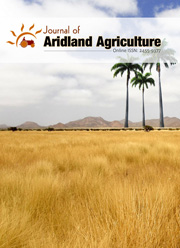Molecular characterization of diosgenin biosynthesis in different organs of Trigonella foenum-graecum L.
DOI:
https://doi.org/10.25081/jaa.2024.v10.8811Keywords:
Trigonella foenum, Bioactive properties, Mature leaves, Diosgenin, Potential, Biosynthesis, SqualeneAbstract
Fenugreek, an annual herb, is a significant source of diosgenin, a triterpene with bioactive properties. This study aimed to molecularly characterize diosgenin biosynthesis in various organs of fenugreek, including flowers, immature leaves, developing leaves, mature leaves, stems, roots, and pods. The biosynthetic pathway involves vital enzymes such as squalene synthase, squalene monooxygenase, cycloartenol synthase, and Sterol-3-ß-glucosyl transferase. The study found that flowers and roots exhibited the highest gene expression levels, indicating their potential significance in diosgenin biosynthesis. Diosgenin content was quantified using high-performance liquid chromatography, with seeds being the primary source. The findings suggest that fenugreek offers a cost-effective and rapid alternative to yam for diosgenin production, and the differential accumulation of diosgenin in different plant organs underscores the importance of understanding organ-specific biosynthesis. This comprehensive analysis provides valuable insights into fenugreek’s potential as a bioresource for diosgenin and its diverse applications in medicine and agriculture.
Downloads
References
Acharya, S., Srichamroen, A., Basu, S., Ooraikul, B., & Basu, T. (2006). Improvement in the nutraceutical properties of fenugreek (Trigonella foenum-graecum L.). Songklanakarin Journal of Science and Technology, 28(S1), 1-9.
Chaudhary, S., Chikara, S. K., Sharma, M. C., Chaudhary, A., Syed, B. A., Chaudhary, P. S., Mehta, A., Patel, M., Ghosh, A., & Iriti, M. (2015). Elicitation of Diosgenin Production in Trigonella foenum-graecum (Fenugreek) Seedlings by Methyl Jasmonate. International Journal of Molecular Sciences, 16(12), 29889-29899. https://doi.org/10.3390/ijms161226208
Ciura, J., Szeliga, M., & Tyrka, M. (2015). Optimization of in vitro culture conditions for accumulation of diosgenin by fenugreek. Journal of Medicinal Plants and Studies, 3(3), 22-25.
De, D., & De, B. (2003). Effect of ethephon on antioxidant enzymes and diosgenin production in seedlings of Trigonella foenum-graecum. Food Chemistry, 82(2), 211-216. https://doi.org/10.1016/S0308-8146(02)00514-9
El-Desouky, T. A. M., Amer, M., & Naguib, K. (2013). Effect of fenugreek seeds extracts on growth of aflatoxigenic fungus and aflatoxin B1 production. Journal of Applied Sciences Research, 9(7), 4418-4425.
George, M., Joseph, L., & Sabu, N. S. (2016). Evaluation of antipyretic and anti-inflammatory activity of seed extract of Trigonella foenum graecum. Journal of Chemical and Pharmaceutical Research, 8(1), 132-135.
Khlifi, S., Jemaa, H. B., Hmad, H. B., Abaza, H., Karmous, I., Abid, A., Benzarti, A., Elati, J., & Aouidet, A. (2016). Antioxidant, antidiabetic and antihyperlipidemic effects of Trigonella foenum-graecum seeds. International Journal of Pharmacology, 12, 394-400. https://doi.org/10.3923/ijp.2016.394.400
Kumar, V., Desai, D., & Shriram, V. (2014). Hairy root induction in Helicteres isora L. and production of diosgenin in hairy roots. Natural Products and Bioprospecting, 4, 107-112. https://doi.org/10.1007/s13659-014-0011-9
Laila, O., & Murtaza, I. (2015). Fenugreek: a treasure of bioactive compounds with promising antidiabetic potential. International Journal of Food and Nutritional Sciences, 4, 149-157.
Liu, K., Zhao, W., Gao, X., Huang, F., Kou, J., & Liu, B. (2012). Diosgenin ameliorates palmitate-induced endothelial dysfunction and insulin resistance via blocking IKKβ and IRS-1 pathways. Atherosclerosis, 223(2), 350-358. https://doi.org/10.1016/j.atherosclerosis.2012.06.012
Mehrafarin, A., Qaderi, A., Rezazadeh, S., Naghdi, B. H., Noormohammadi, G., & Zand, E. (2010). Bioengineering of important secondary metabolites and metabolic pathways in fenugreek (Trigonella foenum-graecum L.). Journal of Medicinal Plants, 9(35), 1-18.
Mozaffari, Z., Azarnia, M., & Angaji, S. A. (2010). Evaluation of toxic effects of Trigonella foenum-graecum leaf aqueous extract on development of long bone tissue in rat fetus. Journal of Medicinal Plants Research, 4(12), 1148-1155.
Rahmati-Yamchi, M., Ghareghomi, S., Haddadchi, G., Milani, M., Aghazadeh, M., & Daroushnejad, H. (2014). Fenugreek extract diosgenin and pure diosgenin inhibit the hTERT gene expression in A549 lung cancer cell line. Molecular Biology Reports, 41, 6247-6252. https://doi.org/10.1007/s11033-014-3505-y
Rezaeian, S. (2011). Assessment of diosgenin production by Trigonella foenum-graecum L. in vitro condition. American Journal of Plant Physiology, 6(5), 261-268. https://doi.org/10.3923/ajpp.2011.261.268
Sharma, S., Malhotra, N., & Sood, H. (2016). Expression analysis of steroid pathway genes revealed positive correlation with diosgenin biosynthesis in Trillium govanianum. Acta Physiologiae Plantarum, 38, 272. https://doi.org/10.1007/s11738-016-2289-1
Snehlata, H. S., & Payal, D. R. (2012). Fenugreek (Trigonella foenum-graecum L.): an overview. International Journal of Current Pharmaceutical Review and Research, 2(4), 169-87.
Thimmappa, R., Geisler, K., Louveau. T., O'Maille, P., & Osbourn, A. (2014). Triterpene biosynthesis in plants. Annual Review of Plant Biology, 65, 225-257. https://doi.org/10.1146/annurev-arplant-050312-120229
Tunçtürk, R. (2011). Salinity exposure modifies nutrient concentrations in fenugreek (Trigonella foenum graecum L.). African Journal of Agricultural Research, 6(16), 3685-3690.
Wang, X., Chen, D., Wang, Y., & Xie, J. (2015). De novo transcriptome assembly and the putative biosynthetic pathway of steroidal sapogenins of Dioscorea composita. Plos One, 10(4), e0124560. https://doi.org/10.1371/journal.pone.0124560
Wani, S. A., & Kumar, P. (2016). Fenugreek: a review on its nutraceutical properties and utilization in various food products. Journal of the Saudi Society of Agricultural Sciences, 17(2), 97-106. https://doi.org/10.1016/j.jssas.2016.01.007
Published
How to Cite
Issue
Section
Copyright (c) 2024 Do Yeon Kwon, Jinsu Lim, Ramaraj Sathasivam, Md. Romij Uddin, Jae Kwang Kim, Sang Un Park

This work is licensed under a Creative Commons Attribution-NonCommercial 3.0 Unported License.





 .
.